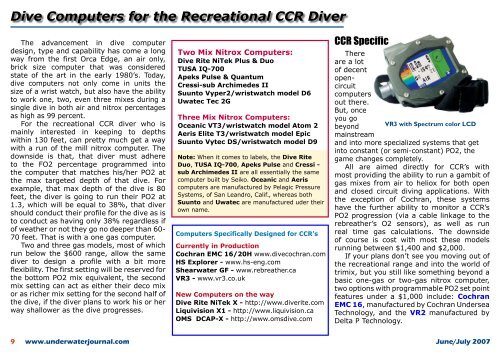- REBREATHERS - SPORT DIVERS ... - Stingray Divers
- REBREATHERS - SPORT DIVERS ... - Stingray Divers
- REBREATHERS - SPORT DIVERS ... - Stingray Divers
Create successful ePaper yourself
Turn your PDF publications into a flip-book with our unique Google optimized e-Paper software.
Dive Computers for the Recreational CCR Diver<br />
The advancement in dive computer<br />
design, type and capability has come a long<br />
way from the first Orca Edge, an air only,<br />
brick size computer that was considered<br />
state of the art in the early 1980’s. Today,<br />
dive computers not only come in units the<br />
size of a wrist watch, but also have the ability<br />
to work one, two, even three mixes during a<br />
single dive in both air and nitrox percentages<br />
as high as 99 percent.<br />
For the recreational CCR diver who is<br />
mainly interested in keeping to depths<br />
within 130 feet, can pretty much get a way<br />
with a run of the mill nitrox computer. The<br />
downside is that, that diver must adhere<br />
to the FO2 percentage programmed into<br />
the computer that matches his/her PO2 at<br />
the max targeted depth of that dive. For<br />
example, that max depth of the dive is 80<br />
feet, the diver is going to run their PO2 at<br />
1.3, which will be equal to 38%, that diver<br />
should conduct their profile for the dive as is<br />
to conduct as having only 38% regardless if<br />
of weather or not they go no deeper than 60-<br />
70 feet. That is with a one gas computer.<br />
Two and three gas models, most of which<br />
run below the $600 range, allow the same<br />
diver to design a profile with a bit more<br />
flexibility. The first setting will be reserved for<br />
the bottom PO2 mix equivalent, the second<br />
mix setting can act as either their deco mix<br />
or as richer mix setting for the second half of<br />
the dive, if the diver plans to work his or her<br />
way shallower as the dive progresses.<br />
Two Mix Nitrox Computers:<br />
Dive Rite NiTek Plus & Duo<br />
TUSA IQ-700<br />
Apeks Pulse & Quantum<br />
Cressi-sub Archimedes II<br />
Suunto Vyper2/wristwatch model D6<br />
Uwatec Tec 2G<br />
Three Mix Nitrox Computers:<br />
Oceanic VT3/wristwatch model Atom 2<br />
Aeris Elite T3/wristwatch model Epic<br />
Suunto Vytec DS/wristwatch model D9<br />
Note: When it comes to labels, the Dive Rite<br />
Duo, TUSA IQ-700, Apeks Pulse and Cressi -<br />
sub Archimedes II are all essentially the same<br />
computer built by Seiko. Oceanic and Aeris<br />
computers are manufactured by Pelagic Pressure<br />
Systems, of San Leandro, Calif., whereas both<br />
Suunto and Uwatec are manufactured uder their<br />
own name.<br />
Computers Specifically Designed for CCR’s<br />
Currently in Production<br />
Cochran EMC 16/20H www.divecochran.com<br />
HS Explorer - www.hs-eng.com<br />
Shearwater GF - www.rebreather.ca<br />
VR3 - www.vr3.co.uk<br />
New Computers on the way<br />
Dive Rite NiTek X - http://www.diverite.com<br />
Liquivision X1 - http://www.liquivision.ca<br />
OMS DCAP-X - http://www.omsdive.com<br />
CCR Specific<br />
There<br />
are a lot<br />
of decent<br />
opencircuit<br />
computers<br />
out there.<br />
But, once<br />
you go<br />
beyond VR3 with Spectrum color LCD<br />
mainstream<br />
and into more specialized systems that get<br />
into constant (or semi-constant) PO2, the<br />
game changes completely.<br />
All are aimed directly for CCR’s with<br />
most providing the ability to run a gambit of<br />
gas mixes from air to heliox for both open<br />
and closed circuit diving applications. With<br />
the exception of Cochran, these systems<br />
have the further ability to monitor a CCR’s<br />
PO2 progression (via a cable linkage to the<br />
rebreather’s O2 sensors), as well as run<br />
real time gas calculations. The downside<br />
of course is cost with most these models<br />
running between $1,400 and $2,000.<br />
If your plans don’t see you moving out of<br />
the recreational range and into the world of<br />
trimix, but you still like something beyond a<br />
basic one-gas or two-gas nitrox computer,<br />
two options with programmable PO2 set point<br />
features under a $1,000 include: Cochran<br />
EMC 16, manufactured by Cochran Undersea<br />
Technology, and the VR2 manufactured by<br />
Delta P Technology.<br />
www.underwaterjournal.com June/July 2007






